Do you know that your favorite Swiss cheese plant is famous for something that you can harvest? Surprised? Here’s How to Grow Monstera Deliciosa Fruit!
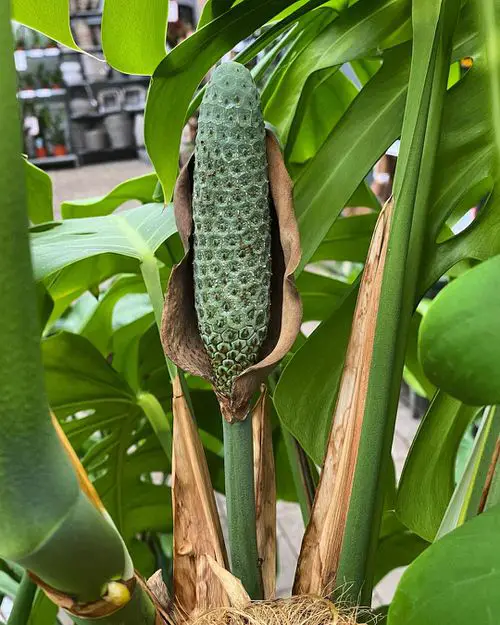
Though the Swiss Cheese Plant is quite popular for its unusual cut foliage, you can also grow it for something else! Yes, for something that you can actually relish. Here’s all you need to know about How to Grow Monstera Deliciosa Fruit.
Monstera Deliciosa Fruit
Monstera deliciosa is primarily grown for its striking leaves and not often for its fruit. Producing fruit on a Monstera deliciosa plant is relatively rare when grown indoors.
- Maturity: The plant needs to be at least a few years old before it can bear fruit.
- Optimal Conditions: Proper light, temperature, and humidity are essential for fruiting.
- Pollination: In natural habitats, the Monstera is pollinated by specific types of insects. Indoor conditions often lack these natural pollinators.
Outdoor plants, or those grown in tropical climates, are more likely to fruit, but even then, it’s not guaranteed.
What Does Monstera Deliciosa Fruit Taste Like?
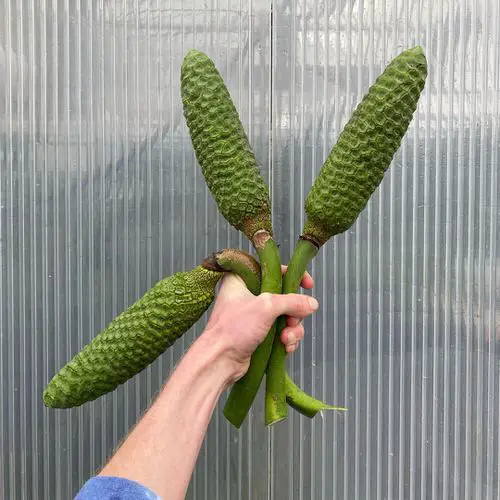
Monstera deliciosa fruit offers a unique taste experience that is often described as a combination of various tropical fruits. The primary flavors noted are:
- Pineapple: The fruit carries a tart, citrusy undertone.
- Banana: A creamy, smooth texture with a hint of sweetness.
- Mango: A tropical, juicy element that rounds out the flavor profile.
Overall, the fruit delivers a complex but harmonious blend of these flavors, making it a rare but delightful treat for those who have the opportunity to try it.
Culinary Uses
Given its distinct flavor, Monstera deliciosa fruit is versatile and can be used in various culinary applications:
- Fresh Consumption: When fully ripe, the fruit can be eaten fresh, much like any other tropical fruit.
- Desserts: Its unique taste makes it an ideal ingredient for puddings, tarts, and tropical fruit salads.
- Smoothies and Juices: The fruit blends well with other tropical fruits, making it a good addition to beverages.
- Garnish: Thin slices or chunks can garnish other dishes, adding both flavor and aesthetic appeal.
How to Grow Monstera Deliciosa Fruit?
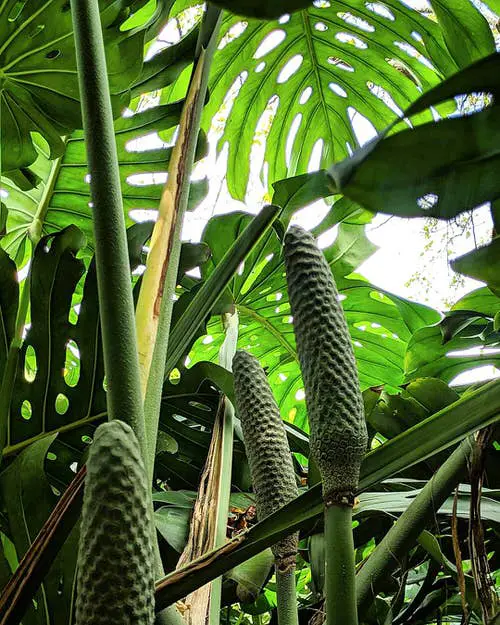
The plant generally starts to grow fruit when it becomes a little mature, not before 2-3 years of its initial growth. However, do remember that not every monstera grows fruit and if yours does, consider yourself lucky!
1. Provide Plenty of Filtered and Indirect Light
To grow healthy, the plant needs a combination of filtered and indirect light for flowering and producing larger fruit. Avoid keeping the plant in a completely dark or shaded spot, and ensure it is exposed to filtered or mild sunlight for some time during the day.
2. Keep Track of the Timing
The plant usually starts to fruit after it sets flowers. There is no specific blooming period in the wild, but it generally does more in summer. After the flower, the fruit will appear, which can be anytime from spring to fall, depending more on the climate.
Keeping track of this time ensures you start to feed it properly 1-2 months prior and also expose it to more light to increase the chances of fruiting.
3. Take It Outdoors
The plant will NEVER fruit if you keep it indoors in low light. It loves warm surroundings and bright indirect daylight, which it can easily get in a garden.
4. Imitate Its Native Environment
If you live in a warm tropical or subtropical climate, then you have a chance of a higher success rate with the plant growing the fruit. Monsteras are native to tropical forests, and mimicking the similar growing requirement will significantly increase the chances of it growing a fruit.
5. Feed It Right
Giving a boost to the plant will trick it into producing fruits. It’d be good to feed the plant with a balanced liquid fertilizer, diluted to half of its strength, at least once in 4 weeks.
How To Eat the Fruit Safely?
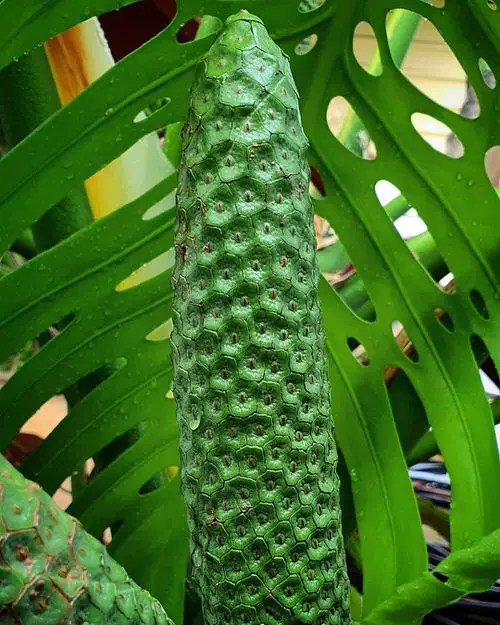
When the fruit is unripe, it is loaded with oxalic acid and can even burn your throat and mouth. It is important to know when to harvest the fruits.
The fruit is a spadix and has green scales on the outer covering. When the lower side of the scales starts to turn yellow, you will know that the fruit has begun to ripen. When the scales start to peel back, cut the fruit from the stem using a sharp knife. At this point, you can wrap it in a paper bag for a few days to help it ripen more.
Risks of Unripe Consumption
- Oral Irritation: Immediate symptoms may include a stinging or burning sensation in the mouth or throat.
- Digestive Distress: Consumption can lead to nausea, vomiting, or diarrhea.
- Skin Irritation: Handling unripe fruit may cause mild skin irritation or itchiness.
Safety Precautions
- Proper Identification: Ensure you are dealing with Monstera deliciosa and not a similar but toxic species.
- Ripeness: Only consume the fruit when it is fully ripe. As it ripens, the outer green scales begin to lift, indicating it’s safe to eat.
- Avoid Skin Contact: Wear gloves when handling unripe or partially ripe fruit to prevent skin irritation.
Note: Make sure to pick off any black flecks you notice and throw them. The black flecks are the calcium oxalate leftover and can still cause that irritation, so be sure to discard them.
Benefits of Eating Monstera Deliciosa Fruit
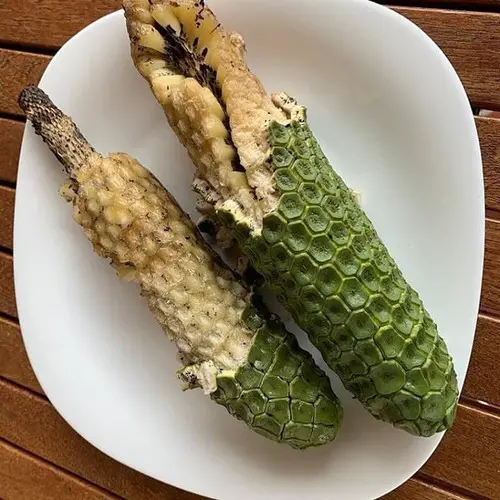
Nutritional Profile
While comprehensive nutritional data on Monstera deliciosa fruit is limited due to its rarity, it is generally considered to be similar to other tropical fruits in its profile. It is likely to contain:
- Vitamin C: Good for immune function and skin health.
- Dietary Fiber: Helpful for digestion and may assist in weight management.
- Potassium: Vital for heart health and blood pressure regulation.
- Antioxidants: Known for fighting free radicals and oxidative stress.
- Natural Sugars: Provide a quick source of energy.
Though it’s not a widely researched subject, eating Monstera deliciosa fruit could offer several health advantages based on its presumed nutritional profile:
1. Immune System Boost
The Vitamin C content can contribute to strengthening the immune system, making it easier for the body to fight off infections and illnesses.
2. Digestive Health
The dietary fiber present in the fruit can aid in digestion, potentially preventing constipation and promoting gut health.
3. Cardiovascular Health
Potassium plays a critical role in maintaining heart health. It helps regulate blood pressure and may reduce the risk of cardiovascular diseases.
4. Antioxidant Properties
Antioxidants found in the fruit can help reduce oxidative stress, which in turn may lower the risk of chronic diseases such as cancer and heart disease.
5. Energy Boost
The natural sugars in Monstera deliciosa fruit can offer a quick energy boost, making it a suitable snack for physically active individuals.


